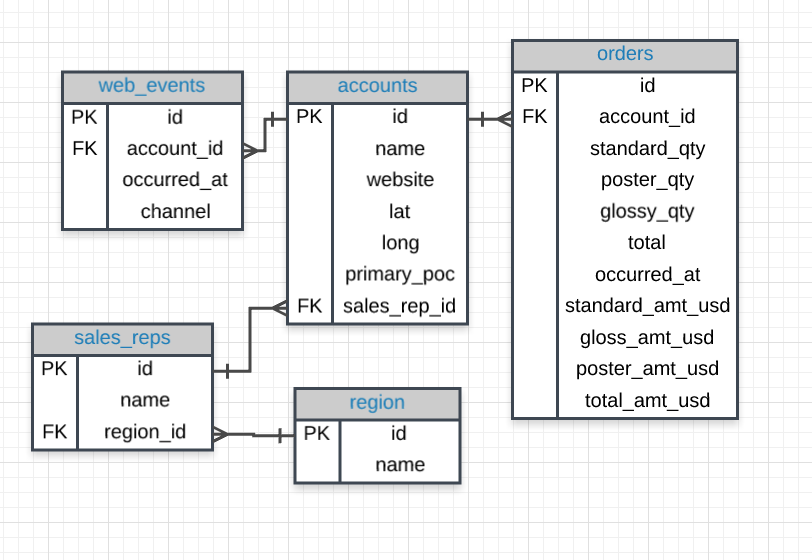数据分析 SQL 基础 [课程]
SQL for Data Analysis [Course]

Course source: Udacity - https://www.udacity.com/course/sql-for-data-analysis--ud198
Statements
SELECT … FROM … shows part/all of data in a table.
LIMIT limits reading to the first few rows.
ORDER BY … [DESC] sort rows by column(s).
WHERE filters rows by column.
Examples:
SELECT colname FROM tablename;
SELECT colname
FROM tablename; /* white spaces allowed in commands */
SELECT colname1, colname2 /* select multiple columns */
FROM tablename;
SELECT * /* select all columns */
FROM tablename
LIMIT 10; /* only first 10 rows */
SELECT *
FROM tablename
ORDER BY colname /* sort rows ascending by column */
LIMIT 10;
SELECT *
FROM tablename
ORDER BY colname DESC /* sort rows descending by column */
LIMIT 10;
SELECT *
FROM tablename
ORDER BY colname1 DESC, colname2 /* sort rows asc./desc. by multiple columns */
LIMIT 10;
SELECT *
FROM tablename
WHERE colname1 >= 100 /* only select rows with numerical colname1 >= 100 */
LIMIT 10;
SELECT *
FROM tablename
WHERE colname1 = 'Yes' /* only select rows with non-numerical colname1 'Yes' */
LIMIT 10;
SELECT id, account_id,
poster_amt_usd/(standard_amt_usd + gloss_amt_usd) AS post_per
FROM orders; /* arithmetic operation and results put in a new column */
Logical Operators
LIKE - This allows you to perform operations similar to using WHERE and =, but for cases when you might not know exactly what you are looking for.
IN - This allows you to perform operations similar to using WHERE and =, but for more than one condition.
NOT - This is used with IN and LIKE to select all of the rows NOT LIKE or NOT IN a certain condition.
AND & BETWEEN - These allow you to combine operations where all combined conditions must be true.
OR - This allow you to combine operations where at least one of the combined conditions must be true.
Examples:
SELECT *
FROM demo.web_events_full
WHERE ref_url LIKE '%google%'; /* % means any characters of any length */
SELECT *
FROM demo.web_events_full
WHERE ref_url NOT LIKE '%google%'; /* NOT LIKE */
SELECT *
FROM tablename
WHERE name IN ('string1','string2'); /* contains any of the strings */
SELECT *
FROM tablename
WHERE name IN ('string1','string2'); /* NOT IN */
SELECT *
FROM tablename
WHERE id IN (100, 121); /* contains any of the numbers */
SELECT *
FROM web_events
WHERE channel IN ('organic', 'adwords') AND
occurred_at BETWEEN '2016-01-01' AND '2017-01-01'
ORDER BY occurred_at DESC;
/* While BETWEEN is generally inclusive of endpoints,
it assumes the time is at 00:00:00 (i.e. midnight) for dates */
SELECT *
FROM accounts
WHERE (name LIKE 'C%' OR name LIKE 'W%')
AND ((primary_poc LIKE '%ana%' OR primary_poc LIKE '%Ana%')
AND primary_poc NOT LIKE '%eana%');
/* Use parentheses to assure the order of operation */
SQL Coding Conventions
-
Capitalizing commands, leave everything else lowercase.
-
Avoid spaces in table and variable names.
-
White spaces are ignored in commands.
-
SQL isn’t case sensitive.
-
Best to put semicolons at the end of Statements.
-
The order of the key words does matter!
Database Normalization
There are essentially three ideas that are aimed at database normalization:
-
Are the tables storing logical groupings of the data?
-
Can I make changes in a single location, rather than in many tables for the same information?
-
Can I access and manipulate data quickly and efficiently?
This is discussed in detail here.
JOIN
The whole goal of JOIN statements is to allow us to pull from more than one table at a time. An Entity-Relationship Diagram (ERD) shows the relationships between tables:

The PK here stands for primary key. This is the first column in each of our tables that has a unique value for every row. A foreign key (FK) is when we see a primary key in another table.
Examples:
SELECT orders.*
FROM orders /* table from which to pull data */
JOIN accounts /* table to merge */
ON orders.account_id = accounts.id; /* how to merge */
/* Notice this result is the same as if you switched the tables in the FROM and
JOIN. Additionally, which side of the = a column is listed doesn't matter. */
SELECT orders.standard_qty, orders.gloss_qty,
orders.poster_qty, accounts.website,
accounts.primary_poc
FROM orders
JOIN accounts
ON orders.account_id = accounts.id
/* Notice that we need to specify every table a column comes from in the
SELECT statement. */